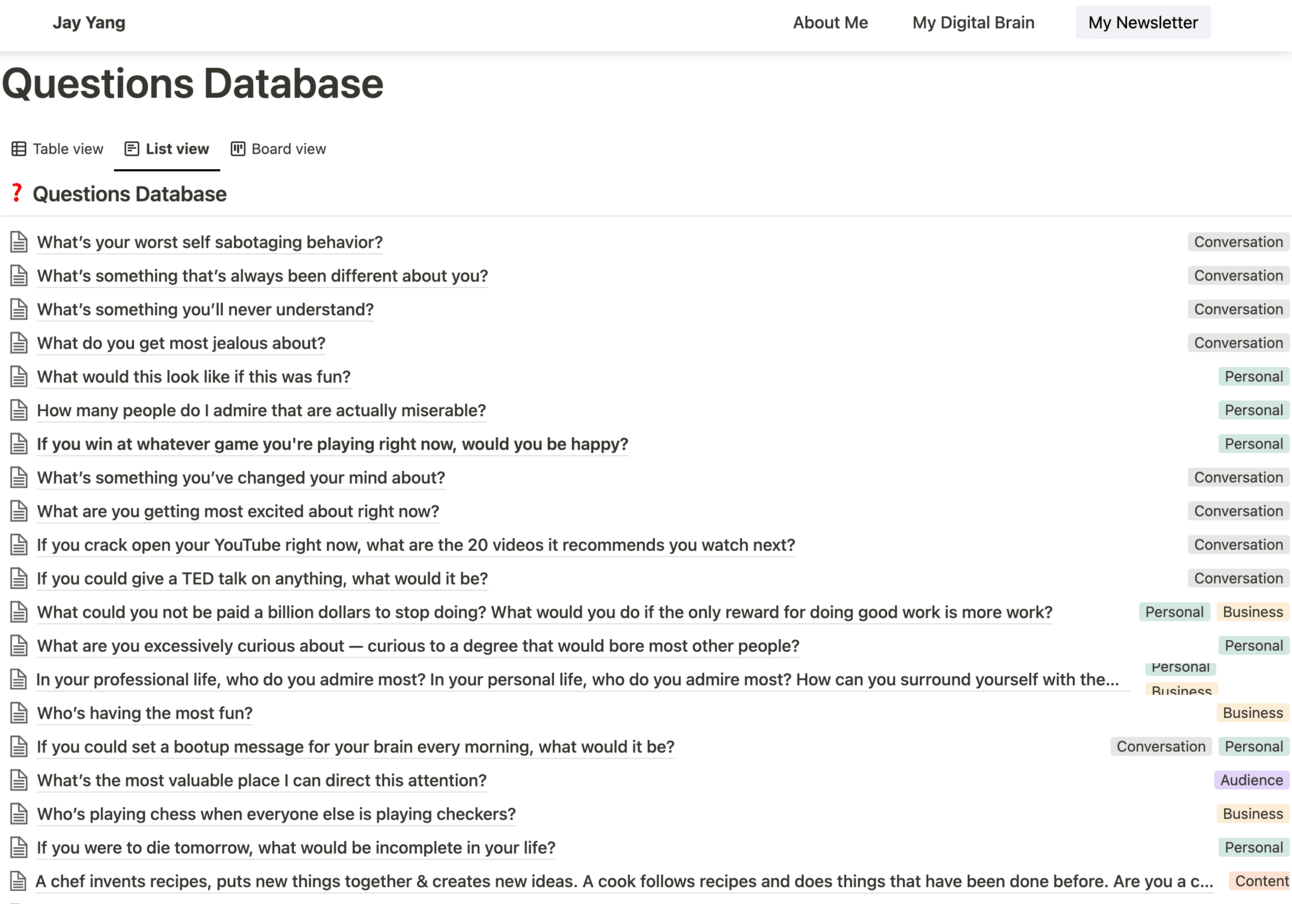
Welcome to Curious Jay, a weekly newsletter where I share actionable ideas on life, work, & business.
This Week’s Newsletter:
I’m on my way to Austin for Noah Kagan’s book launch party.
I’m excited (yet a little nervous) to meet people I’ve looked up to for a while. So I decided to revisit a few pieces of conversation tips I’ve picked up over time.
5 strategies to have better conversations: (1) Never the naked introduction, (2) Prepare sound bites, (3) Use the repeat-and-follow method, (4) Be a word detective, and (5) Create a question bank.
We all know those people. They walk into the room and people flock to them like moths attracted to light. With them, conversation is easy. They give off a pleasant vibe.
We also know people who are the exact opposite of that. Conversations with them are stale, bland, and boring.
What separates charismatic conversationalists from everyone else?
Today, I want to share 5 of the most useful strategies I’ve found for having better conversations.
Let’s dive in…
1) Never The Naked Introduction
“Hey, I’m Dylan. Where are you from?”
“Chicago.”
“Oh cool, I’ve never been.”
“It’s nice.”
“Nice.”
“…”
“…”
That was how many of my early conversations began when I met new people.
Awkward, right?
Don’t be like me. Instead, create ‘threads’ for people to hook and hang on to.
“Hey, I’m Dylan. Where are you from?”
“Chicago. Where the summers are sweltering hot and the winters are icy cold. I don’t mind though, I’m more of a homebody myself. Most of my time is spent in my room reading, writing my weekly newsletter, or working out in the basement.”
Do you see how many threads the other person has to dive deeper into?
Conversational Threading is a technique to continue the conversation without the other person feeling like they’re carrying the conversation.
Essentially, each thread is a launchpad for people to start a deeper, more meaningful conversation. Conversational threading increases your surface area for overlapping interests.
Give people something to latch onto. Create threads.
2) Prepare Sound Bites
Conversations are like a game of basketball. If you hog the ball for too long, you risk upsetting the other players. Instead, pass the ball and pivot the conversation to the other person early and often.
To ensure I’m not overtalking, I like to prepare sound bites for common questions.
Sound bites help concisely summarize your key points. Politicians often use sound bites when trying to get their message across.
You don’t have to write out paragraphs or even full sentences. But it’s helpful to flesh out a few key points for common questions like the ones listed below.
Tell me about yourself
How’d you get into [what you currently do]?
How do you know [mutual acquaintance]?
What’s your favorite part of [what you do]?
Where do you see yourself 3-5 years from now?
It’s impossible to prepare for every question. But it’s worth preparing a few go-to answers to questions you know will come up often.
3) Use The Repeat-And-Follow Method
The repeat-and-follow method is where you repeat the last words of the other person in a question-like manner to get them to elaborate or clarify their statement.
“Woah! Looks like you’re busy. That’s a lot of paper.”
“Haha, yeah I’ve got a lot of studying to do.”
“Studying to do?”
“Well, I’m going to college for finance and final exams are coming up.”
Sometimes called “Parroting”, the repeat-and-follow method shows you’re listening and are truly interested in what the other person is saying.
It’s like asking “What do you mean?” only better.
“Saw you went to a show last night, how was it?”
“It was a great show. The music was great.”
“The music was great?”
“Yeah, I’ve been a big Taylor Swift fan for a while now. So my friends and I were able to sing the songs with her.”
A word of warning: Only use the repeat-and-follow method when it seems natural. When used too much, it can feel robotic.
4) Be A Word Detective
The key to great conversations boils down to actually listening and wanting to know more about the other person.
Most people talk and then wait to talk again. Instead, resist that urge and fully listen. You’ll pick up cues on when to dig deeper.
Be attentive to the other person’s emotions.
If they get excited talking about a particular topic, dig deeper or ask follow-up questions. If they seem to close up or be uncomfortable, pivot to a different topic.
Let your curiosity be your guide.
5) Create A ‘Question Bank’
Questions are the difference between a bland, dry conversation and an energizing, interesting one.
Bad questions act as red lights:
The person answers it in one statement and the conversation dies.
Good questions act as green lights:
The person answers it in a story structure that sparks even more questions and further develops the connection.
If you come across an interesting question, save it. Over time, you’ll have a bank of questions you can pull from when conversations feel stale.
It doesn’t matter if you’re an introvert or an extrovert, an investment banker or a high school student—conversations rule our lives.
It’s a skill that we all can practice and master.
Use the principles outlined above to kickstart your magical conversations this year.
See you next Sunday,
Jay Yang
PS — Here’s my full questions database. I’m constantly adding and updating it.
What'd you think of this week's newsletter?
Forwarded this email? Sign up here
Follow me on Twitter and LinkedIn


